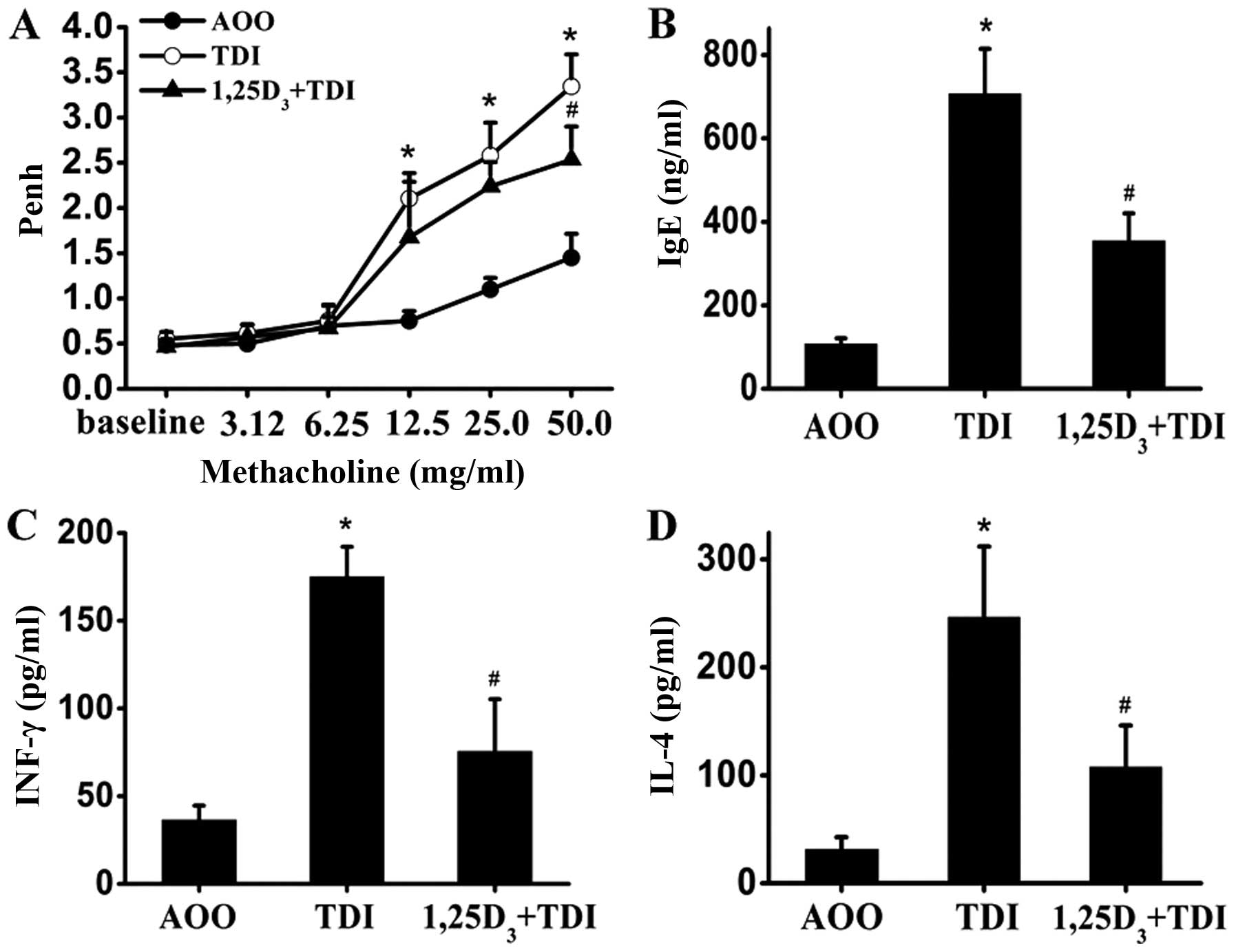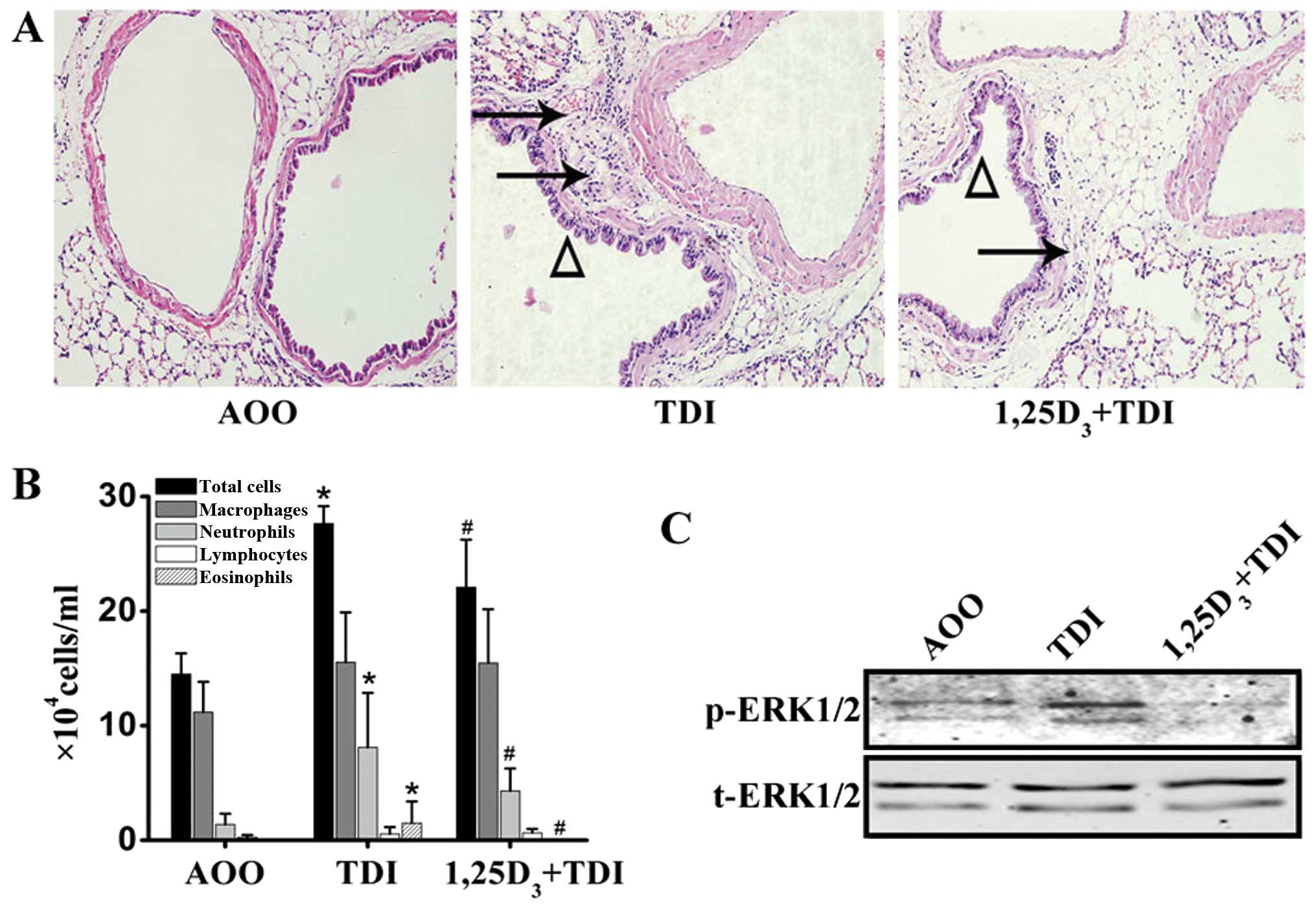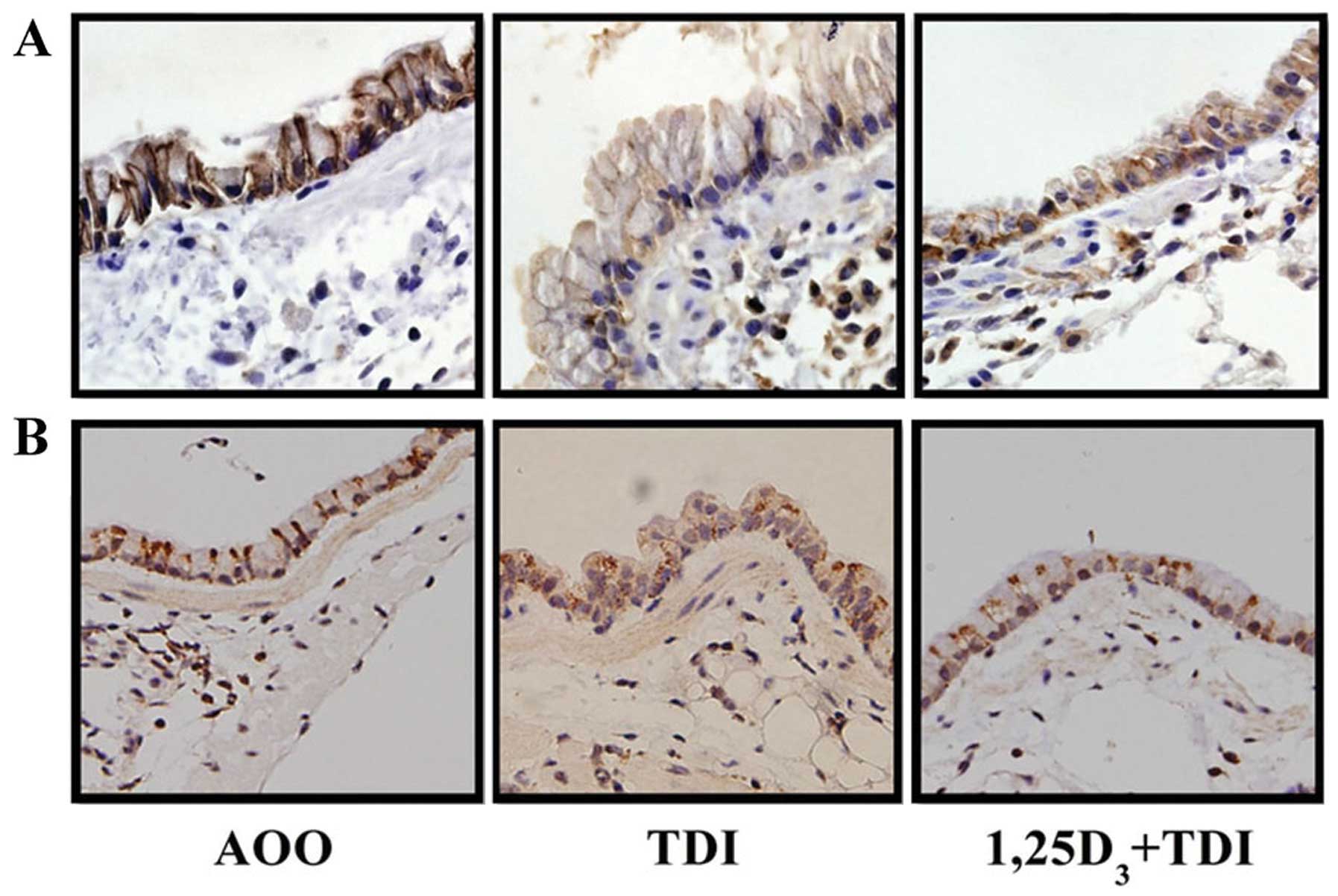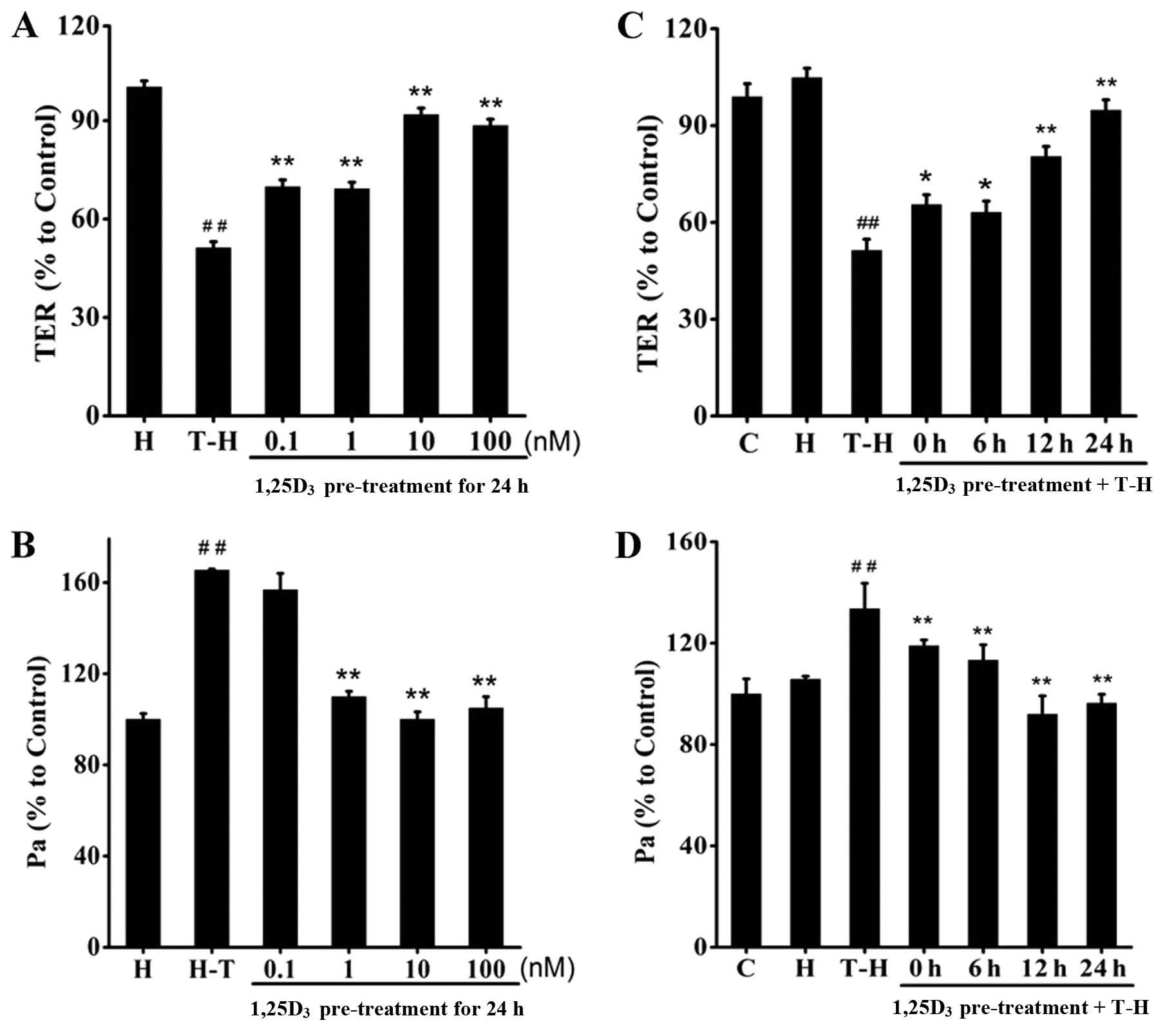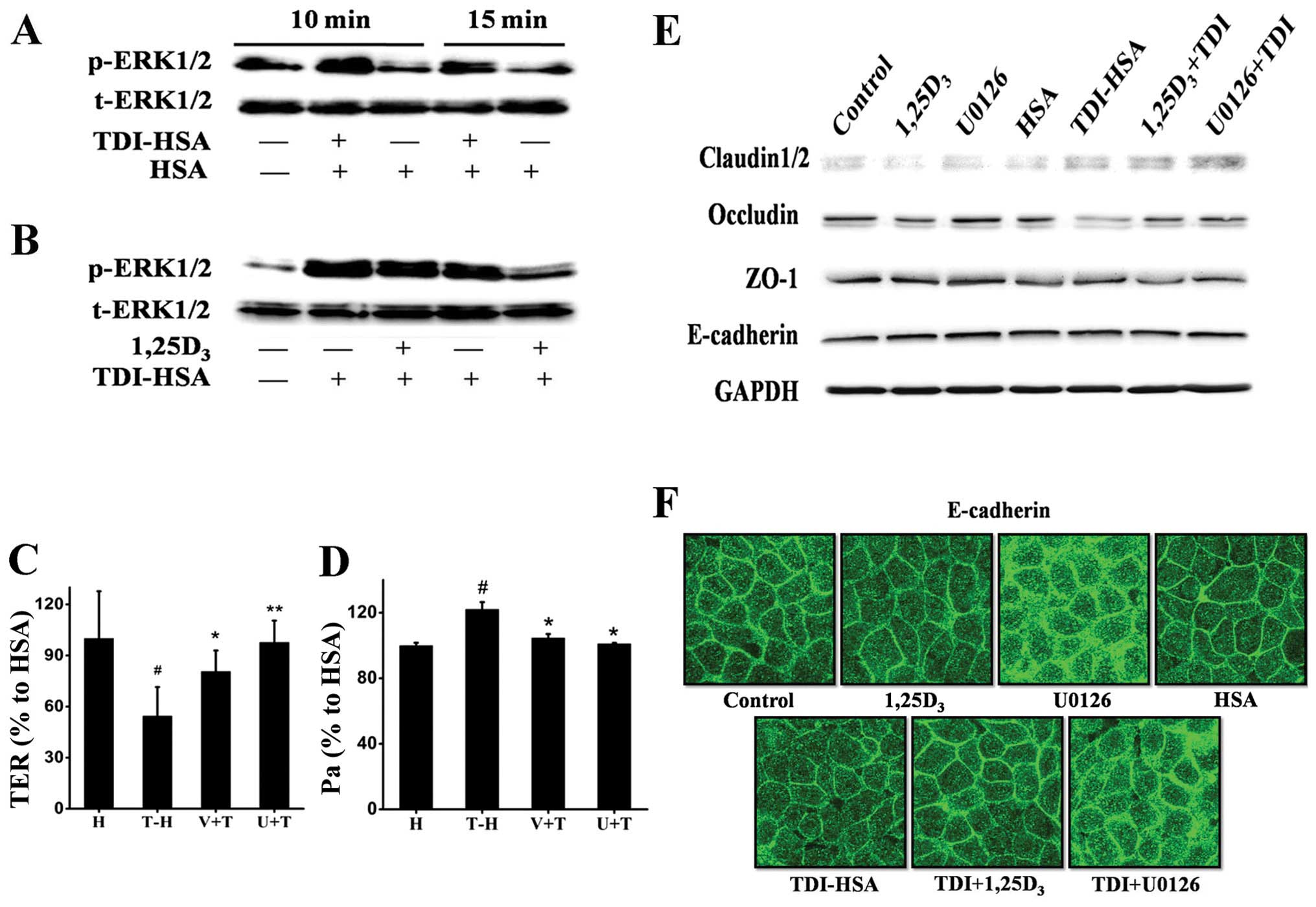1,25-Dihydroxyvitamin D3 prevents toluene diisocyanate-induced airway epithelial barrier disruption
- Authors:
- Published online on: May 19, 2015 https://doi.org/10.3892/ijmm.2015.2214
- Pages: 263-270
Abstract
Introduction
Airway epithelial cells protect the underlying tissue against inhaled allergens, environmental pollutants and respiratory viruses. Airway epithelial cells constitute a highly regulated and impermeable barrier formed by tight junctions (TJs), which are composed of zonula occludens (ZO)1–3, occludin and claudin 1–5, as well as adhesion junctions (AJs), which consist of E-cadherin, β-catenin and junctional adhesion molecule (JAM) (1). E-cadherin is regarded as the ‘gatekeeper’ in the airway mucosa and in allergic sensitization due to its key role in maintaining the stability of epithelial junctions, including TJs (2). Studies have demonstrated that the bronchial epithelial barrier in asthmatic patients is compromised. The expression of ZO-1 and E-cadherin in bronchial epithelial cells obtained from asthmatic patients has been shown to be significantly lower than that in cells obtained from non-asthmatic subjects (3,4). The disruption of the epithelial barrier may facilitate the transport of allergens to allergen-presenting cells and promote the pro-inflammatory activities of the epithelium (5). Increasing evidence suggests that the loss of airway epithelial integrity contributes significantly to asthma pathogenesis (2).
In recent years, lower vitamin D levels have been found to be associated with impaired lung function, increased airway hyperresponsiveness (AHR) and a reduced glucocorticoid response in subjects with asthma (6). However, the detailed mechanisms involved remain poorly understood.
Toluene diisocyanate (TDI) is currently one of the leading causes of occupational asthma. In previous studies, we demonstrated that TDI-human serum albumin (HSA) impaired TJ function, induced E-cadherin redistribution and increased the permeability of bronchial epithelial cells both in vitro and in vivo (7,8). In this study, we aimed to determine whether 1,25-dihydroxyvitamin D3 [1,25(OH)2D3 or 1,25D3] preserves airway epithelial barrier integrity and whether the inhibition of extracellular signal-regulated kinase (ERK)1/2 is involved in this process.
Materials and methods
Animals and agents
Six-week-old male BALB/c mice were purchased from Southern Medical University (Guangzhou, China). The mice were housed in a specific pathogen-free (SPF) environment with a 12-h dark/light cycle. All experiments were conducted in accordance with the guidelines outlined by the committee of Southern Medical University on the use and care of animals. The protocols were approved by the Animal Subjects Committee of Nanfang Hospital. The vehicle (AOO) used to dissolve TDI consisted of a mixture of 2 volumes of acetone and 3 volumes of olive oil for dermal sensitization, and 1 volume of acetone and 4 volumes of olive oil for airway challenge. The concentrations of TDI were provided as a percentage (v/v) in AOO. TDI (toluene-2,4-diisocyanate), acetone and 1,25D3 were obtained from Sigma-Aldrich (Shanghai, China). Enzyme-linked immunosorbent assay (ELISA) kits for IgE, interleukin (IL)-4 and interferon-γ (IFN-γ) were from Boshide Biotechnology (Wuhan, China).
Animal experimental protocol
All the mice were randomly divided into the following 3 groups as follows: i) the AOO group: vehicle (AOO)-sensitized/AOO-challenged and phosphate-buffered saline (PBS)-treated; ii) the TDI group: TDI-sensitized/TDI-challenged and PBS-treated; and iii) 1,25D3 group: TDI-sensitized/TDI-challenged and 1,25D3-treated. The construction of the model of TDI-induced asthma was carried out as previously described (8). Briefly, on days 1 and 8, the animals were dermally treated with 0.3% TDI or the vehicle on the dorsum of both ears (20 µl/ear). On days 15, 18 and 21, the mice underwent an oropharyngeal aspiration (20 µl) with 0.01% TDI or the vehicle. 1,25D3 (100 ng/mouse) dissolved in 300 µl PBS containing 0.9% ethanol was administered to the mice by intraperitoneal injection 1 day prior to challenge with TDI for 8 consecutive days. The control mice received 300 µl PBS containing 0.9% ethanol by comparison. The methods for the measurements of airway reactivity, airway inflammation, and the expression levels of E-cadherin, ZO-1 and phosphorylated (p-) ERK1/2 in the airway mucosa of the mice were as previously described (8). The measurement of airway reactivity was carried out using methacholine. AHR to methacholine was assessed 24 h after the third challenge. Briefly, the mice were placed in a barometric plethysmographic chamber (Buxco Electronics, Troy, NY, USA). Aerosolized methacholine (Sigma-Aldrich) in increasing concentrations (0–50 mg/ml) was nebulized through an inlet of the main chamber for 3 min. Readings were taken and averaged for 3 min after each nebulization. The bronchopulmonary resistance was expressed as enhanced pause (Penh).
Hematoxylin and eosin (H&E) staining was used for the measurement of airway inflammation. Briefly, the mice were humanely euthanized with pentobarbital (100 mg/kg body weight, administered intraperitoneally) and the lungs were removed. The left lungs were infused with 4% formaldehyde. The lungs were fixed and embedded in paraffin. Sections (4-µm-thick) were cut using a Leica microtome 2030 (Leica Microsystems Nussloch GmbH, Nussloch, Germany). The slides were stained with H&E.
Preparation of TDI-HSA conjugates
TDI-HSA conjugates were prepared by a modification of the method described in the study by Son et al (9) and the method used for the calculation of the amount of TDI bound to HSA was as previously described (7).
Epithelial cell culture and exposure to TDI-HAS
The human bronchial epithelial cell line, 16HBE, (Shanghai Fuxiang Biological Technology Co., Ltd., Shanghai, China) was used in this study due to its highly characterized intercellular adhesion properties (10). The 16HBE cells were grown in a cell culture flask in Dulbecco’s modified Eagle’s medium (DMEM) (Ginuo Biopharm Technology Co., Shanghai, China) with 10% fetal calf serum (FCS; Invitrogen, Gibco, Carlsbad, CA, USA) and placed in a humidified incubator at 37°C with 5% CO2. When reaching 90% confluence, the cells were trypsinized and seeded into proper culture plates at a density of 104–105 cells/cm2. When the cells had grown to complete confluence, they were pre-treated with or without 1,25D3 (0.1 to 100 nM for 6 to 24 h) or the ERK1/2 selective inhibitor, U0126 (25 µM, for 1 h; Cell Signaling Technology, Beverly, MA, USA). Subsequently, 100 µg/ml TDI-HSA conjugate were added to the culture medium followed by incubation for 24 h. The concentration of 1,25D3 and U0126 used in this study was in accordance with that used in previous studies (11,12). Cell viability was detected using a MTT colorimetric assay.
Measurement of the transepithelial electrical resistance (TER) of the epithelial monolayer
The method used for measuring TER was as described in the study of Sekiyama et al (13). In brief, the 16HBE cells were seeded at a density of 2×105 cells/cm2 onto the apical chamber of Polyester Membrane Transwell-Clear Inserts (Cat. no. 3460; Corning Inc., Corning, NY, USA) and incubated at 37°C until complete confluence was reached. Cell monolayer integrity was evaluated by measuring TER using a Millicell ERS-2 Epithelial Volt-Ohm Meter (Millipore, Billerica, MA, USA). TER (Ω × cm2) was calculated by (TER sample - TER blank) × surface area (cm2). The percentage change in TER following treatment was calculated as follows: TER(%) = (TER test/TER control) ×100, where the TER sample is the initial reading of each chamber, the TER blank is the reading of the no-cell control chamber, the TER test is the real value of each chamber, and the TER control is the reading of the no treatment control chamber.
Measurement of the permeability of fluorescein isothiocyanate-dextran (FITC-Dx) in the epithelial monolayer
The measurement of the FITC-Dx (70 kDa) flux was carried out using a previously described method (7). Briefly, the 16HBE cells were grown in Transwell inserts to achieve complete confluence. The cells were pre-treated with or without 1,25(OH)2D3, or the ERK1/2 inhibitor, U0126, and 100 µg/ml TDI-HSA conjugates were added to the culture medium followed by incubation for 24 h. At the end of the exposure period, the apical and basolateral chambers were washed twice with PBS, and FITC-Dx (0.5 mg/ml in phenol red-free DMEM) was then added to the apical chamber at a level of 0.5 ml, and 1.0 ml phenol red-free DMEM (Gibco, Carlsbad, CA, USA) was added to the basolateral chambers. The plates were then incubated at 37°C for 90 min. The samples from the apical and basolateral chambers were collected and data were read using a TECAN Infinite M200 fluorometer (Tecan, Maennedorf, Switzerland) with an excitation/emission wavelength of 495/520 nm.
Western blot analysis and immunofluorescence staining
The cells were grown to confluence, and then harvested and washed twice with ice-cold PBS. The cells were subsequently lysed in cell lysis buffer (KeyGen Biotech, Nanjing, China) containing protease inhibitor, calcineurin inhibitors and PMSF, and centrifuged at 12,000 x g for 15 min at 4°C. The protein products were normalized and boiled with standard SDS sample buffer, then separated by 8% (ZO-1) or 10% (E-cadherin, occludin, claudin-1/2, ERK1/2 and p-ERK1/2) sodium dodecyl sulfate-polyacrylamide (SDS) gel electrophoresis and transferred onto polyvinylidene fluoride membranes. The membranes were then blocked with 5% BSA (for p-ERK1/2 only) or skim milk at room temperature for 2 h, and incubated with anti-ZO-1 (sc-10804), anti-E-cadherin (sc-7870), anti-occludin (sc-5562), anti-claudin-1/2 (sc-28668) (Santa Cruz Biotechnology, Santa Cruz, CA, USA), anti-ERK1/2 and anti-p-ERK1/2 (#9101S) antibodies (Cell Signaling Technology) at 4°C overnight, and then incubated with anti-rabbit IgG (#7074; Cell Signaling Technology) at room temperature for 1 h. The immunoreactive bands were detected using an enhanced chemiluminescence ECL system (DingGuo Biotech Co., Ltd., Guangzhou, China).
In a parallel experiment, the 16HBE cells were seeded at a density of 1×105 cells/cm2 on a cell culture dish (35×12 mm, 15 mm glass bottom; Nest Biotechnology Co., Ltd., Shanghai, China) until confluent. The cells were then fixed with 4% para-formaldehyde at room temperature for 15 min, washed with ice-cold PBS for 15 min, incubated with 0.2% Triton X-100 in PBS for 10 min, and rinsed again with PBS. The cells were blocked with 5% skim milk for 2 h. All samples were subsequently incubated with rabbit polyclonal anti-E-cadherin and FITC-linked anti-rabbit IgG (ZF-0311; Zhongshan Jinqiao Biotechnology Co., Ltd., Beijing, China). The cell nuclei were stained with 4′,6-diamidino-2-phenylindole dihydrochloride (Sigma-Aldrich). A laser scanning confocal microscope (Olympus, Tokyo, Japan) was utilized to examine the distribution of junction proteins in the 16HBE cells. The images were processed with FV10-ASW1.7 Viewer and Photoshop.
Statistical analysis
Statistical analysis was performed using SPSS software version 13.0. Data are expressed as the means ± standard error (SE) and comparisons among groups were analyzed by one-way ANOVA accompanied by the LSD test for multiple comparisons. A value of P<0.05 was considered to indicate a statistically significant difference.
Results
1,25D3 decreases AHR, and the levels of serum IgE, IL-4 and IFN-γ in the mouse model of TDI-induced asthma
The pulmonary assessment of enhanced pause (Penh) was used to determine airway reactivity to methacholine. As shown in Fig. 1A, the Penh values were significantly increased in the TDI-treated mice compared with the controls following stimulation with methacholine (12.5, 25 and 50 mg/ml) (P<0.05); these values decreased after the administration of 1,25D3 (methacholine, 50 mg/ml) (P<0.05). Similarly, there was a robust elevation in the serum IgE levels when the mice were sensitized and challenged with TDI; this effect was inhibited by 1,25D3 (Fig. 1B). At the same time, the TDI-induced release of IL-4 (Th2-related) and IFN-γ (Th1-related) was also suppressed by treatment with 1,25D3 (Fig. 1C and D).
1,25D3 prevents TDI-induced airway inflammation
The mice sensitized and challenged with TDI displayed marked inflammation in the peribronchial regions, as well as epithelial hyperplasia, as indicated by H&E staining of the sections (Fig. 2A). The analysis of the number of total and differential cells in the bronchoalveolar lavage (BAL) fluid revealed a significant increase in the number of total inflammatory cells, neutrophils and eosinophils following challenge with TDI (Fig. 2B). Treatment with 1,25D3 markedly mitigated peribronchial inflammation and inflammatory cell accumulation into the airway lumen (Fig. 2A and B).
1,25D3 inhibits the phosphorylation of ERK1/2 in the lungs induced by TDI
The pulmonary expression of p-ERK1/2 was determined by western blot analysis. There was a marked increase in the expression levels of activated ERK1/2 following airway challenge with TDI, which was then significantly inhibited by treatment with 1,25D3 (n=3) (Fig. 2C).
1,25D3 inhibits the TDI-induced delocalization of E-cadherin and ZO-1 at the epithelial cell-cell contact sites of the airway mucosa
The sections subjected to immunofluorescence staining showed a strong immunoreactivity of E-cadherin and ZO-1 at the lateral side and apicolateral border of the airway epithelial cells, while challenge with TDI resulted in much fainter staining of the two junction proteins at the epithelial cell-cell contact sites; these effects were partially reversed by treatment with 1,25D3 (Fig. 3).
TDI-HSA impairs the barrier integrity of 16HBE cells
Each concentration of TDI-HSA we used had no detectable effect on cell viability (data not shown). TER was measured to determine epithelial barrier integrity. TER decreased immediately following the addition of TDI-HSA (100 µg/ml) to the culture plates and this decrease lasted for >24 h (Fig. 4A).
We then assessed the total cell lysates by western blot analysis to determine whether the epxression levels of TJ and AJ proteins were downregulated. We observed a decrease in the expression of occludin that was in parallel with the changes observed in TER. A transient abnormal expression of ZO-1 and claudin-1/2 was also detected, while the total protein expression of E-cadherin was relatively unaltered (Fig. 4B).
1,25D3 prevents TDI-induced barrier disruption in 16HBE cells
The TDI-HSA-treated 16HBE cells were pre-treated with 1,25D3 at the indicated concentrations (0.1–100 nM) (Fig. 5A and B) for the indicated periods of time (0, 6, 12 and 24 h) (Fig. 5C and D). We observed that treatment with 1,25D3 significantly reversed the decrease in TER and increased FITC-Dx permeability. Treatment with 1,25D3 at the dose of 10 nM for 24 h achieved the most prominent protective effects.
1,25D3 prevents TDI-induced epithelial barrier disruption and inhibits ERK1/2 phosphorylation in vitro
In line with the aforementioned results using the mice with TDI-induced asthma, we observed an increase in the levels of p-ERK1/2 when the 16HBE cells were stimulated with TDI-HSA (Fig. 6A); this effect was reversed by treatment with 1,25D3 (Fig. 6B), suggesting that the ERK1/2 pathway may be involved in this process. Thus, we compared the effects of 1,25D3 with those of the selective ERK1/2 inhibitor, U0126, on the maintenance of airway epithelial integrity. Treatment with both 1,25D3 and U0126 significantly increased TER (Fig. 6C), decreased FITC-Dx permeability (Fig. 6D), elevated the protein expression of occludin and claudin-2 (Fig. 6E), and inhibited the delocalization of E-cadherin (Fig. 6F).
Discussion
To the best of our knowledge, this is the first study to demonstrate that 1,25D3 alleviates airway inflammation and prevents epithelial barrier disruption induced by TDI.
TDI is a small molecular compound widely used in the production of rigid or flexible polyurethane foam, as well as hardeners in urethane spray paints and adhesives. It is one of the most common causes of occupational asthma in many industrialized areas (14). TDI-induced asthma is characterized by AHR, Th2-dominated airway inflammation and granulocytic infiltration (15,16) and is often associated with a poor prognosis. Airway inflammation tends to persist despite inhaled steroid medication even after the cessation of the exposure (17,18). Although there is debate concerning its etiopathogenesis, in our study, mice with TDI-induced asthma displayed similar characteristics as those of affected patients: AHR and inflammatory cell infiltration, higher levels of serum IgE, as well as an imbalanced Th1/Th2 response. Supplementation with 1,25D3 significantly ameliorated airway reactivity and the allergic airway inflammation induced by TDI. These results are in accordance with those of the studies by Gorman et al and Agrawal et al using a model of ovalbumin (OVA)-induced asthma (19,20).
Vitamin D deficiency or lower serum 1,25D3 levels have been linked to a higher morbidity due to asthma, poor disease control, a greater risk of exacerbation and less sensitive responses to steroids (6,21). The mechanisms involved remain incompletely understood, although several have been suggested. Active vitamin D generated in the pulmonary milieu leads to an increased recruitment of macrophages (22) and an enhanced production of cathelicidin (23), therefore potentiating host defenses against alien microorganisms, gases and allergens. Vitamin D has also been found to modulate regulatory T cells (Tregs), an important regulator of asthma pathogenesis (24). Vitamin D (alone or with glucocorticoids) has been reported to promote the differentiation of naive T cells into IL-10-secreting Tregs (25,26). The addition of vitamin D to cell cultures has been shown to increase the glucocorticoid-induced secretion of IL-10 by Tregs (27). In human T cells, vitamin D downregulates dendritic cell OX40 ligand (OX40L), which is required for Th2 priming, thus resulting in compromised Th2 cytokine release (28). However, other researchers have found that vitamin D inhibits the proliferation of CD4-positive T cells and reduces the production of Th1 cytokines (29). On the basis of these observations, it is postulated that the susceptibility to asthma may be enhanced in individuals with suboptimal levels of vitamin D.
We have previously reported that TDI damages TJs and induces E-cadherin delocalization (7,8), both of which are critical for the maintenance of airway epithelial integrity, as well as proper immunological responses against environmental insults (2,30). In agreement with other studies on the corneal and colon epithelium (11,31), in this study, mice administered 1,25D3 showed a better arrangement of E-cadherin and ZO-1 at the adjacent epithelial cell-cell contact sites compared with the vehicle-treated mice challenged with TDI. Subsequent in vitro experiments using 16HBE cells confirmed the role of 1,25D3 in strengthening airway epithelial barrier function. Treatment with 1,25D3 reversed the decrease in TER and the increase in FITC-Dx permeability, which was paralleled with the relatively unaltered expression of E-cadherin and ZO-1, but a stronger staining of E-cadherin at the epithelial junctions, accompanied by upregulated protein levels of occludin and claudin-1/2. As we measured these protein levels in whole cell lysates rather than harvesting membrane fractions to determine the surface labeling of proteins, the paradoxical results of western blot analysis of claudin-1/2 and occludin did not breach our in vivo findings. Further studies are required, including more quantitative measurements of the delocalization of junction proteins.
The ERK pathway was previously proven to be involved in the TDI-induced redistribution of E-cadherin by using the ERK inhibitor, PD98095 (8). This was verified in the present study using another ERK inhibitor (U0126) in vitro. Pre-treatment with U0126 not only attenuated E-cadherin redistribution, but also significantly increased TER and decreased FITC-Dx permeability, further supporting the notion that ERK1/2 activation is of great importance in TDI-induced epithelial barrier disruption. We continued to determine whether the phosphorylation of ERK is diminished by vitamin D. Intriguingly, 1,25D3 exerted potent suppressive effects on ERK1/2 activation both in vivo and in vitro, indicating that the inhibition of ERK1/2 activation may be responsible for the protective effects of vitamin D. Further investigations are warranted to confirm this hypothesis.
In conclusion, the results from the present study demonstrate that 1,25(OH)2D3 prevents TDI-induced airway epithelial barrier disruption, and that the inhibition of the ERK pathway may be involved in this process.
Acknowledgments
This study was supported by grants from the National Natural Science Foundation of China (81270087, 81270089, 81300029 and 81470228), the National Program on Key Basic Research Project (973 program, 2012CB518203), the Special Project on the Integration of Industry, Education and Research of Guangdong (2012B091100153), and the Science and Technology Program of Guangdong (2011B031800245).
References
|
Holgate ST: The airway epithelium is central to the pathogenesis of asthma. Allergol Int. 57:1–10. 2008. View Article : Google Scholar : PubMed/NCBI | |
|
Nawijn MC, Hackett TL, Postma DS, van Oosterhout AJ and Heijink IH: E-cadherin: Gatekeeper of airway mucosa and allergic sensitization. Trends Immunol. 32:248–255. 2011. View Article : Google Scholar : PubMed/NCBI | |
|
de Boer WI, Sharma HS, Baelemans SM, Hoogsteden HC, Lambrecht BN and Braunstahl GJ: Altered expression of epithelial junctional proteins in atopic asthma: Possible role in inflammation. Can J Physiol Pharmacol. 86:105–112. 2008. View Article : Google Scholar : PubMed/NCBI | |
|
Xiao C, Puddicombe SM, Field S, et al: Defective epithelial barrier function in asthma. J Allergy Clin Immunol. 128:549–556. 2011. View Article : Google Scholar : PubMed/NCBI | |
|
Post S, Nawijn MC, Hackett TL, Baranowska M, Gras R, van Oosterhout AJ and Heijink IH: The composition of house dust mite is critical for mucosal barrier dysfunction and allergic sensitisation. Thorax. 67:488–495. 2012. View Article : Google Scholar | |
|
Paul G, Brehm JM, Alcorn JF, Holguín F, Aujla SJ and Celedón JC: Vitamin D and asthma. Am J Respir Crit Care Med. 185:124–132. 2012. View Article : Google Scholar : | |
|
Zhao H, Peng H, Cai SX, Li W, Zou F and Tong W: Toluene diisocyanate enhances human bronchial epithelial cells’ permeability partly through the vascular endothelial growth factor pathway. Clin Exp Allergy. 39:1532–1539. 2009. View Article : Google Scholar : PubMed/NCBI | |
|
Song J, Zhao H, Dong H, Zhang D, Zou M, Tang H, Liu L, Liang Z, Lv Y, Zou F and Cai S: Mechanism of E-cadherin redistribution in bronchial airway epithelial cells in a TDI-induced asthma model. Toxicol Lett. 220:8–14. 2013. View Article : Google Scholar : PubMed/NCBI | |
|
Son M, Lee M, Kim YT, Youn JK and Park H: Heterogeneity of IgE response to TDI-HSA conjugates by ELISA in toluene diisocyanate (TDI)-induced occupational asthma (OA) patients. J Korean Med Sci. 13:147–152. 1998. View Article : Google Scholar : PubMed/NCBI | |
|
Wan H, Winton HL, Soeller C, Stewart GA, Thompson PJ, Gruenert DC, Cannell MB, Garrod DR and Robinson C: Tight junction properties of the immortalized human bronchial epithelial cell lines Calu-3 and 16HBE14o-. Eur Respir J. 15:1058–1068. 2000. View Article : Google Scholar : PubMed/NCBI | |
|
Zhao H, Zhang H, Wu H, Li H, Liu L, Guo J, Li C, Shih DQ and Zhang X: Protective role of 1,25(OH)2 vitamin D3 in the mucosal injury and epithelial barrier disruption in DSS-induced acute colitis in mice. BMC Gastroenterol. 12:572012. View Article : Google Scholar | |
|
Petecchia L, Sabatini F, Varesio L, Camoirano A, Usai C, Pezzolo A and Rossi GA: Bronchial airway epithelial cell damage following exposure to cigarette smoke includes disassembly of tight junction components mediated by the extracellular signal-regulated kinase 1/2 pathway. Chest. 135:1502–1512. 2009. View Article : Google Scholar : PubMed/NCBI | |
|
Sekiyama A, Gon Y, Terakado M, Takeshita I, Kozu Y, Maruoka S, Matsumoto K and Hashimoto S: Glucocorticoids enhance airway epithelial barrier integrity. Int Immunopharmacol. 12:350–357. 2012. View Article : Google Scholar : PubMed/NCBI | |
|
Tarlo SM and Lemiere C: Occupational asthma. N Engl J Med. 370:640–649. 2014. View Article : Google Scholar : PubMed/NCBI | |
|
Ban M, Morel G, Langonné I, Huguet N, Pépin E and Binet S: TDI can induce respiratory allergy with Th2-dominated response in mice. Toxicology. 218:39–47. 2006. View Article : Google Scholar | |
|
De Vooght V, Smulders S, Haenen S, Belmans J, Opdenakker G, Verbeken E, Nemery B, Hoet PH and Vanoirbeek JA: Neutrophil and eosinophil granulocytes as key players in a mouse model of chemical-induced asthma. Toxicol Sci. 131:406–418. 2013. View Article : Google Scholar | |
|
Piirilä PL, Meuronen A, Majuri ML, Luukkonen R, Mäntylä T, Wolff HJ, Nordman H, Alenius H and Laitinen A: Inflammation and functional outcome in diisocyanate-induced asthma after cessation of exposure. Allergy. 63:583–591. 2008. View Article : Google Scholar : PubMed/NCBI | |
|
Talini D, Novelli F, Bacci E, Costa F, Dente FL, Di Franco A, Malagrinò L, Vagaggini B and Paggiaro P: Mild improvement in symptoms and pulmonary function in a long-term follow-up of patients with toluene diisocyanate-induced asthma. Int Arch Allergy Immunol. 161:189–194. 2013. View Article : Google Scholar : PubMed/NCBI | |
|
Gorman S, Weeden CE, Tan DH, Scott NM, Hart J, Foong RE, Mok D, Stephens N, Zosky G and Hart PH: Reversible control by vitamin D of granulocytes and bacteria in the lungs of mice: An ovalbumin-induced model of allergic airway disease. PLoS One. 8:e678232013. View Article : Google Scholar : PubMed/NCBI | |
|
Agrawal T, Gupta GK and Agrawal DK: Vitamin D supplementation reduces airway hyperresponsiveness and allergic airway inflammation in a murine model. Clin Exp Allergy. 43:672–683. 2013.PubMed/NCBI | |
|
Samrah S, Khatib I, Omari M, Khassawneh B, Momany S, Daoud A, Malkawi M and Khader Y: Vitamin D deficiency and level of asthma control in women from North of Jordan: A case-control study. J Asthma. 51:832–838. 2014. View Article : Google Scholar : PubMed/NCBI | |
|
Griffin MD, Xing N and Kumar R: Vitamin D and its analogs as regulators of immune activation and antigen presentation. Annu Rev Nutr. 23:117–145. 2003. View Article : Google Scholar : PubMed/NCBI | |
|
Herr C, Shaykhiev R and Bals R: The role of cathelicidin and defensins in pulmonary inflammatory diseases. Expert Opin Biol Ther. 7:1449–1461. 2007. View Article : Google Scholar : PubMed/NCBI | |
|
Hawrylowicz CM and O’Garra A: Potential role of interleukin-10-secreting regulatory T cells in allergy and asthma. Nat Rev Immunol. 5:271–283. 2005. View Article : Google Scholar : PubMed/NCBI | |
|
Urry Z, Xystrakis E, Richards DF, McDonald J, Sattar Z, Cousins DJ, Corrigan CJ, Hickman E, Brown Z and Hawrylowicz CM: Ligation of TLR9 induced on human IL-10-secreting Tregs by 1alpha,25-dihydroxyvitamin D3 abrogates regulatory function. J Clin Invest. 119:387–398. 2009.PubMed/NCBI | |
|
Barrat FJ, Cua DJ, Boonstra A, Richards DF, Crain C, Savelkoul HF, de Waal-Malefyt R, Coffman RL, Hawrylowicz CM and O’Garra A: In vitro generation of interleukin 10-producing regulatory CD4(+) T cells is induced by immunosuppressive drugs and inhibited by T helper type 1 (Th1)- and Th2-inducing cytokines. J Exp Med. 195:603–616. 2002. View Article : Google Scholar : PubMed/NCBI | |
|
Xystrakis E, Kusumakar S, Boswell S, et al: Reversing the defective induction of IL-10-secreting regulatory T cells in glucocorticoid-resistant asthma patients. J Clin Invest. 116:146–155. 2006. View Article : Google Scholar | |
|
Kreindler JL, Steele C, Nguyen N, et al: Vitamin D3 attenuates Th2 responses to Aspergillus fumigatus mounted by CD4+ T cells from cystic fibrosis patients with allergic bronchopulmonary aspergillosis. J Clin Invest. 120:3242–3254. 2010. View Article : Google Scholar : PubMed/NCBI | |
|
Mahon BD, Wittke A, Weaver V and Cantorna MT: The targets of vitamin D depend on the differentiation and activation status of CD4 positive T cells. J Cell Biochem. 89:922–932. 2003. View Article : Google Scholar : PubMed/NCBI | |
|
Georas SN and Rezaee F: Epithelial barrier function: At the front line of asthma immunology and allergic airway inflammation. J Allergy Clin Immunol. 134:509–520. 2014. View Article : Google Scholar : PubMed/NCBI | |
|
Yin Z, Pintea V, Lin Y, Hammock BD and Watsky MA: Vitamin D enhances corneal epithelial barrier function. Invest Ophthalmol Vis Sci. 52:7359–7364. 2011. View Article : Google Scholar : PubMed/NCBI |



